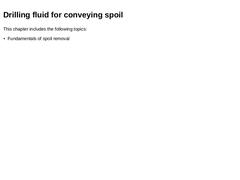
|
|
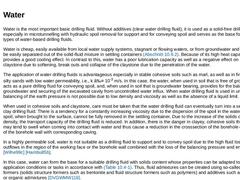
|
Water is the most important basic drilling fluid. Without additives (clear water drilling fluid), it is used as a solid-free drilling fluid especially in microtunnelling with hydraulic spoil removal for support and for conveying spoil and serves as the base for all other types of water-based drilling fluids. Water is cheap, easily available from local water supply systems, stagnant or flowing waters, or from groundwater and can usually be easily separated … |
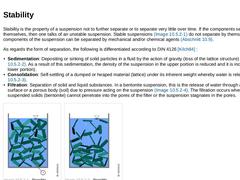
|
Stability is the property of a suspension not to further separate or to separate very little over time. If the components separate themselves, then one talks of an unstable suspension. Stable suspensions (Bild 10.4.1) do not separate by themselves but the components of the suspension can be separated by mechanical and/or chemical agents (Abschnitt 10.9). As regards the form of separation, the following is differentiated according to DIN 4126 [Kilch84] : |

|
|
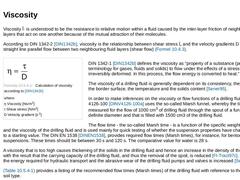
|
Viscosity η is understood to be the resistance to relative motion within a fluid caused by the inter-layer friction of neighbouring fluid layers that act on one another because of the mutual attraction of their molecules. According to DIN 1342-2 [DIN1342b], viscosity is the relationship between shear stress τ and the velocity gradients D within a level, straight line parallel flow between two neighbouring fluid layers (shear flow) (Formel 10.4.3) |
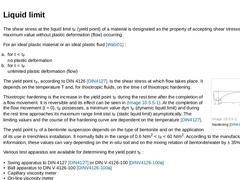
|
The shear stress at the liquid limit τF (yield point) of a material is designated as the property of accepting shear stresses τ up to a maximum value without plastic deformation (flow) occurring. For an ideal plastic material or an ideal plastic fluid [Walz01] : - for τ < τF
no plastic deformation
- for τ = τF
unlimited plastic deformation (flow)
(Image: Thixotropic hardening [DIN4127])
The yield point τF, according to DIN 4126 [DIN4127], is the shear stress … |
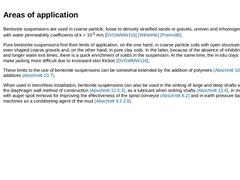
|
Bentonite suspensions are used in coarse particle, loose to densely stratified sands or gravels, uneven and inhomogeneous soils with water permeability coefficients of k > 10-3 m/s [DVGWMW116] [Wilhe99c] [Prems98]. Pure bentonite suspensions find their limits of application, on the one hand, in coarse particle soils with open structures such as even shaped coarse gravels and, on the other hand, in pure clay soils. In the latter, because of the absence … |
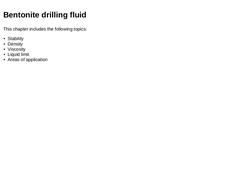
|
|
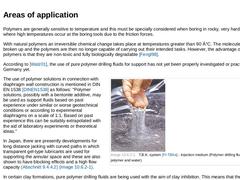
|
Polymers are generally sensitive to temperature and this must be specially considered when boring in rocky, very hard formations where high temperatures occur at the boring tools due to the friction forces. With natural polymers an irreversible chemical change takes place at temperatures greater than 90 °C. The molecule chains are broken up and the polymers are then no longer capable of carrying out their intended tasks. However, the advantage of … |
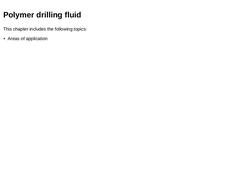
|
|
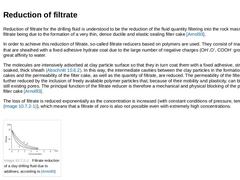
|
Reduction of filtrate for the drilling fluid is understood to be the reduction of the fluid quantity filtering into the rock mass - the loss of filtrate being due to the formation of a very thin, dense ductile and elastic sealing filter cake [Arnol93]. In order to achieve this reduction of filtrate, so-called filtrate reducers based on polymers are used. They consist of macromolecules that are sheathed with a fixed adhesive hydrate coat due to the … |
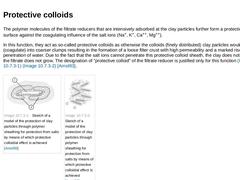
|
The polymer molecules of the filtrate reducers that are intensively adsorbed at the clay particles further form a protection on the clay surface against the coagulating influence of the salt ions (Na+, K+, Ca++, Mg++). In this function, they act as so-called protective colloids as otherwise the colloids (finely distributed) clay particles would ball together (coagulate) into coarser clumps resulting in the formation of a loose filter crust with high … |
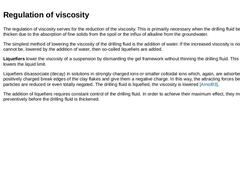
|
The regulation of viscosity serves for the reduction of the viscosity. This is primarily necessary when the drilling fluid begins to thicken due to the absorption of fine solids from the spoil or the influx of alkaline from the groundwater. The simplest method of lowering the viscosity of the drilling fluid is the addition of water. If the increased viscosity is not to be, or cannot be, lowered by the addition of water, then so-called liquefiers are … |
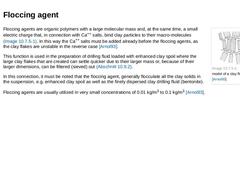
|
(Image: Sketch of a model of a clay flocculant [Arnol93]) Floccing agents are organic polymers with a large molecular mass and, at the same time, a small electric charge that, in connection with Ca++ salts, bind clay particles to their macro-molecules (Bild 10.6.4). In this way the Ca++ salts must be added already before the floccing agents, as the clay flakes are unstable in the reverse case [Arnol93]. This function is used in the preparation of drilling … |
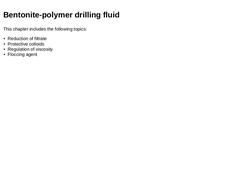
|
|
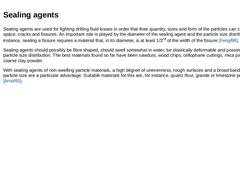
|
Sealing agents are used for fighting drilling fluid losses in order that their quantity, sizes and form of the particles can close the pore space, cracks and fissures. An important role is played by the diameter of the sealing agent and the particle size distribution. For instance, sealing a fissure requires a material that, in its diameter, is at least 1/3rd of the width of the fissure [Fengl98]. Sealing agents should possibly be fibre shaped, should … |
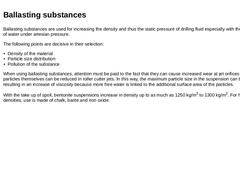
|
Ballasting substances are used for increasing the density and thus the static pressure of drilling fluid especially with the occurrence of water under artesian pressure. The following points are decisive in their selection: - Density of the material
- Particle size distribution
- Pollution of the substance
When using ballasting substances, attention must be paid to the fact that they can cause increased wear at jet orifices and that the particles themselves … |
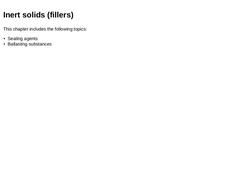
|
|
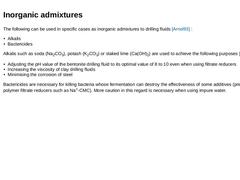
|
The following can be used in specific cases as inorganic admixtures to drilling fluids [Arnol93] : Alkalis such as soda (Na2CO3), potash (K2CO3) or slaked lime (Ca(OH)2) are used to achieve the following
purposes [Arnol93] : - Adjusting the pH value of the bentonite drilling fluid to its optimal value of 8 to 10 even when using filtrate reducers
- Increasing the viscosity of clay drilling fluids
- Minimising the corrosion of steel
|
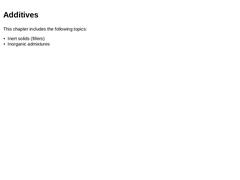
|
|
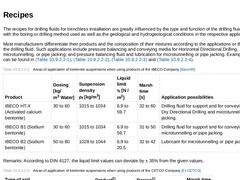
|
The recipes for drilling fluids for trenchless installation are greatly influenced by the type and function of the drilling fluid in connection with the boring or drilling method used as well as the geological and hydrogeological conditions in the respective application. Most manufacturers differentiate their products and the composition of their mixtures according to the applications or the function of the drilling fluid. Such applications include … |

|
|
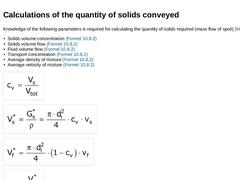
|
Knowledge of the following parameters is required for calculating the quantity of solids required (mass flow of spoil) [Weber74] : - Solids volume concentration (Formel 10.8.2)
- Solids volume flow (Formel 10.8.2)
- Fluid volume flow (Formel 10.8.2)
- Transport concentration (Formel 10.8.2)
- Average density of mixture (Formel 10.8.2)
- Average velocity of mixture (Formel 10.8.2)
(Formula: Calculation of the solids volume concentration cv)
(Formula: Calculation … |
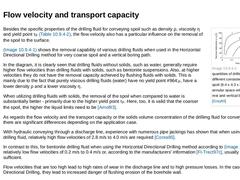
|
(Image: Removal quantities of drilling fluids of different consistencies for model spoil (6.4 x 4.3 x 3.2 mm) in the annular space with drill string at rest and vertical boring path [Gray80]) Besides the specific properties of the drilling fluid for conveying spoil such as density ρ, viscosity η and yield point τF (Tabelle 10.2), the flow velocity also has a particular influence on the removal of the spoil to the surface. Bild 10.8.3 shows the removal … |
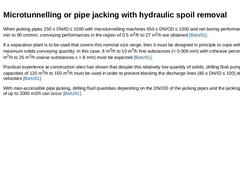
|
When jacking pipes 250 ≤ DN/ID ≤ 1000 with microtunnelling machines 650 ≤ DN/OD ≤ 1300 and net boring performances of 5 cm/min to 90 cm/min, conveying performances in the region of 0.5 m3/h to 27 m3/h are obtained [Bietz91]. If a separation plant is to be used that covers this nominal size range, then it must be designed in principle to cope with the maximum solids conveying quantity. In this case, 8 m3/h to 10 m3/h fine substances (< 0.006 mm) with … |